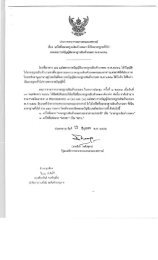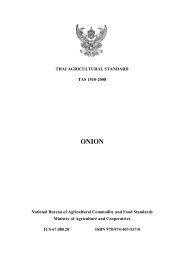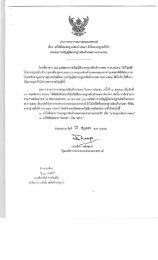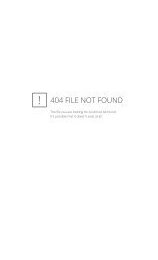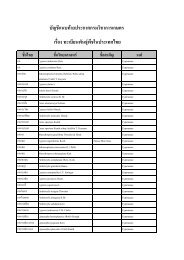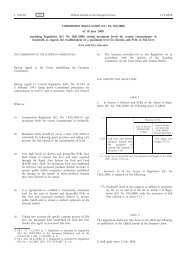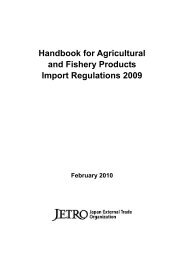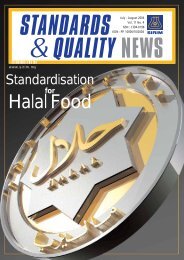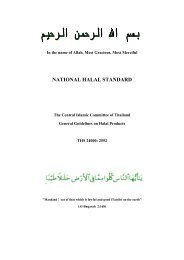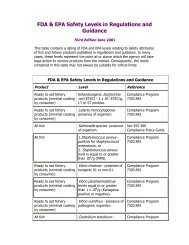Quick Frozen Fish Fillet
Quick Frozen Fish Fillet
Quick Frozen Fish Fillet
Create successful ePaper yourself
Turn your PDF publications into a flip-book with our unique Google optimized e-Paper software.
THAI AGRICULTURAL STANDARD<br />
TAS 7014-2005<br />
QUICK FROZEN FISH FILLETS<br />
National Bureau of Agricultural Commodity and Food Standards<br />
Ministry of Agriculture and Cooperatives<br />
ICS 67.120.30 ISBN 974-403-325-8
UNOFFICIAL TRANSLATION<br />
THAI AGRICULTURAL STANDARD<br />
TAS 7014-2005<br />
QUICK FROZEN FISH FILLETS<br />
National Bureau of Agricultural Commodity and Food Standards<br />
Ministry of Agriculture and Cooperatives<br />
50 Phaholyothin Road, Ladyao, Chatuchak, Bangkok 10900<br />
Telephone (662) 561 2277 www.acfs.go.th<br />
Published in the Royal Gazette Vol. 123 Special Section 11 D,<br />
dated 25 January B.E. 2549 (2005)
Ad hoc Sub Committee on the Elaboration of Standards on <strong>Quick</strong> <strong>Frozen</strong> <strong>Fish</strong>ery Products<br />
1. Associate Professor Prasert Saisithi Chairperson<br />
2. Representative of the <strong>Fish</strong> Inspection and Quality Control Division, Department of <strong>Fish</strong>eries<br />
Mrs. Krissana Sukhumpanich<br />
Mrs.Passarapa Kaewnern (alternate)<br />
3. Representative of the <strong>Fish</strong>ery Technological Development Division, Department of <strong>Fish</strong>eries<br />
Mrs. Pensri Boonruang<br />
Mrs. Niracha Wongchinda (alternate)<br />
4. Representative of the Department of Medical Sciences, Ministry of Public Health<br />
Ms. Piyanart Leewiwat<br />
Ms. Urarat Vuttigornphan (alternate)<br />
5. Representative of the Food and Drug Administration, Ministry of Public Health<br />
Ms. Daranee Mukhajonpun<br />
Ms. Kalayanee Deprasirtvong (alternate)<br />
6. Representative of the Office of Commonity and System Standards,<br />
The National Bureau of Agricultural Commodity and Food Standards<br />
Ms. Metanee Sukontarug<br />
Mrs. Usa Bamrungbhuet (alternate)<br />
7. Representative of the Faculty of <strong>Fish</strong>eries, Kasetsart University<br />
Assistant Professor Mayuree Chaiyawat<br />
Mrs. Pattama Ratana-arporn (alternate)<br />
8. Representative of the Faculty of Agro-Industry, Kasetsart University<br />
Associate Professor Wunwiboon Garnjanagoonchorn<br />
9. Representative of the Department of Food Technology, Chulalongkorn University<br />
Mr.Kriengsak Duangmal<br />
10. Representative of the Thai <strong>Frozen</strong> Foods Association<br />
Mrs.Watcharawan Chomdong<br />
Ms. Nareerat Junthong (alternate)<br />
11. Representative of the Federation of Thai Industries<br />
-<br />
12. Representative of the Kingfisher Holdings Ltd.<br />
Ms. Pornpimon Intes<br />
13. Representative of the National Bureau of Agricultural Commodity and Food Standards<br />
Ms. Yupa Laojindapan<br />
Secretary<br />
14. Representatives of the National Bureau of Agricultural Commodity and Food Standards<br />
Mr. Chaisak Ringluen<br />
Assistant Secretary<br />
Ms. Nattima Aungratnakorn
(3)<br />
<strong>Quick</strong> frozen fish fillets are one of the important fishery products of Thailand. Currently, the<br />
manufacturing of quick frozen fish fillets for domestic market and for export is continuously<br />
increasing. It is deemed necessary for the Ministry of Agriculture and Cooperatives to<br />
establish Thai Agricultural Standard for <strong>Quick</strong> <strong>Frozen</strong> <strong>Fish</strong> <strong>Fillet</strong>s for the manufacturers to<br />
use as the guidelines to produce safe and quality products for consumers.<br />
This standard is established by using the following documents as the guidelines:<br />
FAO/WHO. 1995. Codex Alimentarius Volume 1A. General Requirements, Codex General<br />
Standard for the Labelling of Prepackaged Foods (CODEX STAN 1-1985, Rev.1-1991) Joint<br />
FAO/WHO Food Standard Programme, FAO, Rome. 23-31<br />
FAO/WHO. 2001. Codex Alimentarius Volume 1B. General Requirements, Recommended<br />
International Code of Practice General Principles of Food Hygiene (CAC/RCP 1-1969,<br />
Rev.3-1997, Amd. 1999) Joint FAO/WHO Food Standard Programme, FAO, Rome. 1-29<br />
FAO/WHO. 2001. Codex Alimentarius Volume 9A. <strong>Fish</strong> and <strong>Fish</strong>ery Products. Codex<br />
Guidelines for Sensory Evaluation of <strong>Fish</strong> and Shellfish in Laboratories (CAC-GL 31-1999)<br />
Joint FAO/WHO Food Standard Programme, FAO, Rome. 115-140<br />
FAO/WHO. 2001. Codex Alimentarius Volume 9A. <strong>Fish</strong> and <strong>Fish</strong>ery Product. Codex<br />
Standard for <strong>Quick</strong> <strong>Frozen</strong> <strong>Fish</strong> <strong>Fillet</strong>s (CODEX STAN 190-1995) Joint FAO/WHO Food<br />
Standard Programme, FAO, Rome. 3-8<br />
Remark:<br />
The standard title has been revised from “Thai Agricultural Commodity and Food Standard<br />
(TACFS)” to “Thai Agricultural Standard (TAS)” in accordance with the enforcement of the<br />
Agricultural Standards Act B.E. 2551 (2008).
NOTIFICATION OF THE NATIONAL COMMITTEE ON<br />
AGRICULTURAL COMMODITY AND FOOD STANDARDS<br />
SUBJECT: THAI AGRICULTURAL COMMODITY AND FOOD STANDARD:<br />
QUICK FROZEN FISH FILLETS<br />
The resolution of the 2/2548 session of the National Committee on Agricultural<br />
Commodity and Food Standards dated 29 August B.E. 2548 (2005) endorsed the Thai<br />
Agricultural Commodities and Food Standards entitled <strong>Quick</strong> <strong>Frozen</strong> <strong>Fish</strong> <strong>Fillet</strong>s. This<br />
standard would be of benefits for quality improvement, facilitating trade and protecting<br />
consumers.<br />
By virtue of the Cabinet Resolution on Appointment and Authorization of the<br />
National Committee on Agricultural Commodity and Food Standards dated 19 November B.E.<br />
2545 (2002), the Notifies on Thai Agricultural Commodity and Food Standard entitled <strong>Quick</strong><br />
<strong>Frozen</strong> <strong>Fish</strong> <strong>Fillet</strong>s is hereby issued as voluntary standard, the details of which are attached<br />
herewith.<br />
Notified on 29 September B.E. 2548 (2005)<br />
Khunying Sudarat Keyuraphan<br />
Minister of Agriculture and Cooperatives<br />
Chairperson of the National Committee on Agricultural Commodity and Food Standards
NOTIFICATION OF THE NATIONAL COMMITTEE ON<br />
AGRICULTURAL COMMODITY AND FOOD STANDARDS<br />
SUBJECT: THAI AGRICULTURAL COMMODITY AND FOOD STANDARD:<br />
QUICK FROZEN FISH FILLETS<br />
The resolution of the 2/2548 session of the National Committee on Agricultural<br />
Commodity and Food Standards dated 29 August B.E. 2548 (2005) endorsed the Thai<br />
Agricultural Commodities and Food Standards entitled <strong>Quick</strong> <strong>Frozen</strong> <strong>Fish</strong> <strong>Fillet</strong>s. This<br />
standard would be of benefits for quality improvement, facilitating trade and protecting<br />
consumers.<br />
By virtue of the Cabinet Resolution on Appointment and Authorization of the<br />
National Committee on Agricultural Commodity and Food Standards dated 19 November B.E.<br />
2545 (2002), the Notifies on Thai Agricultural Commodity and Food Standard entitled <strong>Quick</strong><br />
<strong>Frozen</strong> <strong>Fish</strong> <strong>Fillet</strong>s is hereby issued as voluntary standard, the details of which are attached<br />
herewith.<br />
Notified on 29 September B.E. 2548 (2005)<br />
Khunying Sudarat Keyuraphan<br />
Minister of Agriculture and Cooperatives<br />
Chairperson of the National Committee on Agricultural Commodity and Food Standards
TAS 7014-2005<br />
THAI AGRICULTURAL STANDARD<br />
QUICK FROZEN FISH FILLETS<br />
1 SCOPE<br />
This standard applies to quick frozen fish fillets for direct consumption. It does not apply to<br />
products intended for further processing or for other industrial purposes.<br />
2 DESCRIPTION<br />
2.1 Product Definition<br />
2.1.1 <strong>Fish</strong> fillet means slices of fish of irregular size and shape which are removed from the<br />
carcass by cuts made parallel to the backbone and pieces of such fillet, with or without the<br />
skin.<br />
2.1.2 <strong>Quick</strong> frozen fish fillet mean slices of fish of irregular size and shape which are<br />
removed from the carcass of the same species of fish suitable for human consumption by cuts<br />
made parallel to the backbone and sections of such fillets cut so as to facilitate packing, and<br />
further quick frozen process.<br />
2.2 Process Definition<br />
2.2.1 The quick frozen processing means the freezing carried out in appropriate equipment<br />
in such a way that the range of temperature of maximum crystallization is passed quickly.<br />
The product after any suitable preparation shall be subjected to a freezing process and shall<br />
comply with the conditions laid down hereafter. The quick freezing process shall not be<br />
regarded as complete unless and until the product temperature has reached -18ºC (0ºF) or<br />
lower at the thermal centre after thermal stabilization.<br />
2.2.2 The quick frozen fish fillet processing means the fish fillet in 2.1.1 taken to further<br />
process in 2.2.1 where the process and packaging shall minimize dehydration and oxidation.<br />
The product shall be kept deep frozen so as to maintain the quality during transportation,<br />
storage and distribution.<br />
The recognized practice of repacking quick frozen products under controlled conditions shall<br />
maintain the quality of the product, followed by the reapplication of the quick freezing<br />
process as defined, where necessary.<br />
2.3 Presentation<br />
2.3.1 Any acceptable product shall meet all requirements of this standard<br />
2.3.2 Information of product is adequately described on the label to avoid confusing or<br />
misleading the consumer.<br />
2.3.3 Type of the product shall be described such as “fish fillet with the skin or fish fillet<br />
without the skin.”
TAS 7014-2005 2<br />
2.3.4 <strong>Fish</strong> fillets may be presented as boneless, provided that boning has been completed<br />
including the removal of pin-bones.<br />
3 ESSENTIAL COMPOSITION AND QUALITY FACTORS<br />
3.1 ESSENTIAL COMPOSITION<br />
3.1.1 <strong>Fish</strong><br />
<strong>Quick</strong> frozen fish fillets shall be prepared from sound fish which are of a quality fit to be sold<br />
fresh for human consumption.<br />
3.1.2 Glazing<br />
If glazed, the water used for glazing or preparing glazing solutions shall be of potable quality<br />
or shall be clean sea-water. Potable water is fresh-water fit for human consumption.<br />
Standards of potability shall not be less than those contained in the latest edition of the<br />
Ministry of Public Health Declaration "Potable Water". Clean sea-water is sea-water which<br />
meets the same microbiological standards as potable water and is free from objectionable<br />
substances.<br />
3.1.3 Other Ingredients<br />
All other ingredients used shall be of food grade quality.<br />
3.2 QUALITY FACTORS<br />
3.2.1 Decomposition<br />
The products shall not contain more than 10 mg/100 g of histamine based on the average of<br />
the sample unit tested. This shall apply only to species of Clupeidae, Scombridae,<br />
Scombresocidae, Pomatomidae and Coryphaenedae families.<br />
3.2.2 Defects<br />
A sample unit shall be considered as defective when it exhibits any of the properties defined<br />
below:<br />
(1) Dehydration<br />
Greater than 10% of the surface area of the sample unit or for pack sizes described below,<br />
exhibits excessive loss of moisture clearly shown as white or yellow abnormality on the<br />
surface, which masks the colour of the flesh and penetrates below the surface, and cannot be<br />
easily removed by scraping with a knife or other sharp instrument without unduly affecting<br />
the appearance of the product.<br />
Pack Size<br />
Defect Area<br />
a) < 200 g units > 25 cm 2<br />
b) 201-500 g units > 50 cm 2<br />
c) 501-5000 g units > 150 cm 2
3<br />
TAS 7014-2005<br />
(2) Foreign Matter<br />
The presence in the sample unit of any matter, which has not been derived from fish, does not<br />
pose a threat to human health, and is readily recognized without magnification or is present at<br />
a level determined by any method including magnification that indicates non-compliance<br />
with good manufacturing and sanitation practices.<br />
(3) Parasites<br />
The presence of two or more parasites per kg of the sample unit detected by the method<br />
described in 9.2.1.2 with a capsular diameter greater than 3 mm or a parasite not encapsulated<br />
and greater than 10 mm in length.<br />
(4) Bones (in packs designated boneless)<br />
More than one bone per kg of product greater or equal to 10 mm in length, or greater or equal<br />
to 1 mm in diameter;<br />
A bone less than or equal to 5 mm in length, is not considered a defect if its diameter is not<br />
more than 2 mm.<br />
The foot of a bone (where it has been attached to the vertebra) shall be disregarded if its<br />
width is less than or equal to 2 mm, or if it can easily be stripped off with a fingernail.<br />
(5) Odour and Flavour<br />
A sample unit affected by persistent and distinct objectionable odours or flavours<br />
characteristic of decomposition, rancidity or feed.<br />
(6) Flesh Abnormalities<br />
A sample unit affected by excessive gelatinous condition of the flesh together with greater<br />
than 86% moisture found in any individual fillet or a sample unit with pasty texture resulting<br />
from parasitic infestation affecting more than 5% of the sample unit by weight.<br />
In the determination of the defectives, products will be considered as meeting the<br />
requirements of this standard when lots examined in accordance with section 10. Products<br />
shall be examined by the methods given in Section 9.<br />
4 FOOD ADDITIVES<br />
Additive<br />
Moisture/Water Retention Agents<br />
Monosodium orthophosphate<br />
Monopotassium orthophosphate<br />
Tetrasodium diphosphate<br />
Tetrapotassium diphosphate<br />
Pentasodium triphosphate<br />
Pentapotassium triphosphate<br />
Sodium polyphosphate<br />
Calcium, polyphosphates<br />
Sodium alginate<br />
Antioxidants<br />
Sodium ascorbate<br />
Potassium ascorbate<br />
Maximum level in the final product<br />
5000 mg/kg expressed as P 2<br />
O 5,<br />
singly<br />
or in combination (includes natural<br />
phosphate)<br />
GMP<br />
GMP<br />
GMP
TAS 7014-2005 4<br />
5 CONTAMINANTS<br />
In compliance with the provisions of the relevant laws and requirements under the Thai<br />
Agricultural Standard on Contaminants.<br />
6 VETERINARY DRUG RESIDUES<br />
In compliance with the provisions of the relevant laws and requirements under the Thai<br />
Agricultural Standard on Residues of Veterinary Drug in Foods<br />
7 HYGIENE<br />
7.1 The final product shall be free from any foreign material that poses a threat to human<br />
health.<br />
7.2 Microbial counts shall be within the limit as described below. Analytical methods are<br />
according to Section 9.2.3 of this standard.<br />
(1) Total viable counts<br />
Total viable counts shall not exceed 5x10 5 CFU/g of product and the number of samples with<br />
total viable counts within 5x10 5 - 10 7 CFU/g of product shall not exceed 3 out of 5.<br />
(2) Escherichai coli<br />
The Most Probable Number (MPN) of Escherichai coli shall not exceed 10/g of product and<br />
the number of samples with MPN of Escherichai coli within 10-100/g of product shall not<br />
exceed 3 out of 5.<br />
(3) Staphylococcus aureus<br />
The Most Probable Number (MPN) of Staphylococcus aureus shall not exceed 100/g of<br />
product.<br />
(4) Salmonella spp.<br />
Salmonella spp. shall not be found in 25g of product.<br />
(5) Vibrio cholerae<br />
Vibrio cholerae shall not be found in 25g of product.<br />
7.3 Histamine<br />
The product shall not contain histamine that exceeds 20 mg/kg. This applies only to species<br />
of Clupeidae, Scombridae, Scombresocidae, Pomatomidae and Coryphaenedae families.<br />
7.4 The product shall not contain any other substance amounts which may pose a hazard to<br />
human health.
5<br />
TAS 7014-2005<br />
7.5 The products covered by this standard be prepared and handled in accordance with the<br />
appropriate sections of the Recommended International Code of Practice-General Principles<br />
of Food Hygiene (CAC/RCP 1-1969), relevant laws and Thai Agricultural Standard<br />
(TAS 7410) entitled Code of Practice for <strong>Fish</strong> and <strong>Fish</strong>ery Products<br />
8 LABELLING<br />
8.1 LABELLING OF RETAIL CONTAINERS<br />
Code, marking and detail information’s shall be legibly appeared on the container in such as a<br />
way that they shall not mislead the consumers. The following specific provisions shall be<br />
applied.<br />
8.1.1 The name of the product as declared on the label shall be "...fillets" or "fillets of..."<br />
and “quick frozen…” or “frozen…”.<br />
8.1.2 Products shall be designated as fish fillet with or without the skin, or boneless as<br />
relevant.<br />
8.1.3 Net weight shall be declared in gram or kilogram.<br />
8.1.4 Where the food has been glazed the declaration of net contents of the food shall be<br />
exclusive of the glaze.<br />
8.1.5 If the product has been glazed with sea-water, a statement to this effect shall be made.<br />
8.1.6 Expiring and manufacturing dates.<br />
8.1.7 Name and address of manufacturer, packer for local product, OR name and address of<br />
importer and country of origin as the case may be.<br />
8.1.8 Lot identification<br />
8.1.9 Storage instruction. The label shall include terms to indicate that the product shall be<br />
stored at a temperature of -18 o C or colder including transportation and distribution.<br />
8.2 LABELLING OF NON-RETAIL CONTAINERS<br />
Information under the provisions of 8.1 shall be given either on the container or in<br />
accompanying documents, except that the name of the product, lot identification, and the<br />
name and address of the manufacturer or packer as well as storage instructions, shall appear<br />
on the container.<br />
However, lot identification, and the name and address of the manufacturer or packer may be<br />
replaced by an identification mark provided that such a mark is clearly identifiable with the<br />
accompanying documents.
TAS 7014-2005 6<br />
9 SAMPLING, EXAMINATION AND ANALYSES<br />
9.1 SAMPLING<br />
9.1.1 Sampling of lots for examination of the product shall be in accordance with relevant laws<br />
and requirements of the Thai Agricultural Standard on Sampling Method. The sample unit may<br />
be a primary container with at least a 1 kg portion of the sample unit.<br />
9.1.2 Sampling of lots for examination of net weight shall be carried out in accordance with<br />
relevant laws and requirements of the Thai Agricultural Standard on Sampling Method.<br />
9.2 ANALYTICAL METHODS<br />
9.2.1 Sensory and Physical Examination<br />
Samples taken for sensory and physical examination shall be assessed by persons trained in<br />
such examination and in accordance with procedures elaborated in Sections 9.2.1.1 through<br />
9.2.1.4, and the Guidelines for the Sensory Evaluation of <strong>Fish</strong> and Shellfish in Laboratories<br />
(CAC/GL 31 - 1999).<br />
9.2.1.1 Determination of Net Weight<br />
(1) Determination of net weight of products not covered by glaze<br />
The net weight (exclusive of packaging material) of each sample unit representing a lot shall<br />
be determined in the frozen state.<br />
(2) Determination of net weight of products covered by glaze procedure<br />
As soon as the package is removed from low temperature storage, open immediately and<br />
place the contents under a gentle spray of cold water. Agitate carefully so that the product is<br />
not broken. Spray until all ice glaze is removed. Remove adhering water by the use of paper<br />
towel and weight the product in a tared pan.<br />
9.2.1.2 Procedure for the Detection of Parasites in Skinless <strong>Fillet</strong>s<br />
The entire sample unit is examined non-destructively by placing appropriate portions of the<br />
thawed sample unit on a 5 mm thick acryl sheet with 45% translucency and candled with a<br />
light source giving 1500 lux 30 cm above the sheet or other equivalent methods.<br />
9.2.1.3 Determination of Gelatinous Condition<br />
According to the AOAC Methods - "Moisture in Meat and Meat Products, Preparation of Sample<br />
Procedure"; 983.18 and "Moisture in Meat" (Method A); 950.46. or other equivalence method.<br />
9.2.1.4 Cooking Methods for sensory and physical examination to confirm odour, flavour and<br />
defectives under Annex A.<br />
The following procedures are based on heating the product to an internal temperature of 65 -<br />
70ºC. The product shall not be overcooked. Cooking times vary according to the size of the<br />
product and the temperatures used. The exact times and conditions of cooking for the<br />
products shall be determined by prior experimentation.<br />
Baking Procedure: Wrap the product in aluminum foil and place it evenly on a flat cookie<br />
sheet or shallow flat pan.
7<br />
TAS 7014-2005<br />
Steaming Procedure: Wrap the product in aluminum foil and place it on a wire rack<br />
suspended over boiling water in a covered container.<br />
Boil-in-Bag Procedure: Place the product in a boilable film-type pouch and seal. Immerse<br />
the pouch in boiling water and cook.<br />
Microwave Procedure: Enclose the product in a container suitable for microwave cooking. If<br />
plastic bags are used, check to ensure that no odour is imparted from the plastic bags. Cook<br />
according to equipment instructions.<br />
9.2.2 Chemical Examination<br />
(1) Determination of histamine According to the AOAC Methods 977.13 latest edition or<br />
other equivalent methods.<br />
(2) Determination of Phosphate According to the AOAC Methods (1984) 2.021 57 to 2.025<br />
latest edition or any other equivalent methods.<br />
9.2.3 Analytical Methods for Micro-Organisms<br />
According to USFDA/BAM (Bacteriological Analytical Manual) latest edition or any other<br />
equivalent methods.<br />
10 LOT ACCEPTANCE<br />
A lot will be considered as meeting the requirements of this standard when:<br />
10.1 The total number of "defectives" as classified according to Section 3.2.2 does not<br />
exceed the acceptance number (c) of the appropriate sampling plan in the Section 9<br />
10.2 The average net contents of all containers examined is not less than the declared<br />
weight, provided there is no unreasonable shortage in any containers;<br />
10.3 The Food Additives, Hygiene and Handling and the Labelling requirements of<br />
Sections 4, 5, 6, 7 and 8 are met.
TAS 7014-2005 8<br />
ANNEX A<br />
Sensory and Physical Examination<br />
1. Complete net weight determination, according to defined procedures in Section 9.2.1.1<br />
(deglazed as required).<br />
2. Examine the frozen fillets for the presence of dehydration by measuring those areas<br />
which can only be removed with a knife or other sharp instrument. Measure the total surface<br />
area of the sample unit, and calculate the percentage affected.<br />
3. Thaw and individually examine each fillet in the sample unit for the presence of foreign<br />
matter, parasites, bone where applicable, odour, and flesh abnormality defects.<br />
4. In cases where a final decision on odour cannot be made in the thawed uncooked state, a<br />
small portion of the disputed material (approximately 200 g) is sectioned from the sample unit<br />
and the odour and flavour confirmed without delay by using one of the cooking methods defined<br />
in Section 9.2.1.4<br />
5. In cases where a final decision on gelatinous condition cannot be made in the thawed<br />
uncooked state, the disputed material is sectioned from the product and gelatinous condition<br />
confirmed by cooking as defined in Section 9.2.1.4 or by using the procedure in Section<br />
9.2.1.3 to determine if greater than 86% moisture is present in any fillet. If a cooking<br />
evaluation is inconclusive, then the procedure in 9.2.1.3 would be used to make the exact<br />
determination of moisture content.
9<br />
TAS 7014-2005<br />
ANNEX B-1<br />
Contaminants<br />
In Compliance with the provisions of the relevant laws and regulations in particular the latest<br />
version.<br />
Contaminations shall not exceed the following limits<br />
(1) Lead (Pb) shall not exceed 1 mg/ 1 kg of food 1<br />
(2) Mercury (Hg) shall not exceed 0.5 mg/ 1 kg of food (for sea food) 1<br />
(3) Cadmium (Cd) shall not exceed 0.2 mg/ 1 kg of food 2<br />
Source:<br />
1. Ministry of Public Health Notification Number 98 (1986) on Food Standard<br />
on Contaminants.<br />
2. Department of <strong>Fish</strong>eries, 2004, <strong>Fish</strong>ery Products Standard Part 1 Chemical<br />
Reference Criteria for <strong>Frozen</strong> <strong>Fish</strong>ery Products
TAS 7014-2005 10<br />
ANNEX B-2<br />
Veterinary Drug Residue<br />
In compliance with the provisions of relevant laws and regulation on standards in particular<br />
the latest.<br />
Order Kind of drug residue Maximum residue limit, MRL<br />
(µg/kg of organ or product)<br />
1. Oxytetracyclines/expressed<br />
as oxytetracyclines<br />
200 (1)<br />
Source:<br />
1. Ministry of Public Health Notifications Number 231 (2001) on Veterinary<br />
Drug Residue in Food.<br />
2. Codex Alimentarius. 2003. MRLs for Veterinary Drug in Food (CAC/MRL)<br />
update as at 20 th Session of the Codex Alimentarius Commission.
11<br />
TAS 7014-2005<br />
ANNEX B-3<br />
Sampling and Decision Criteria<br />
In compliance with the provisions of the relevant laws and regulations in particular the latest<br />
version.<br />
1. Defectives<br />
The total number of "defects" shall not exceed the acceptance numbers (c) of the appropriate<br />
sampling plan.<br />
Sampling Plan<br />
Lot size Sampling size (n) Acceptance (c)<br />
200 or less 3 0<br />
201 – 800 6 1<br />
801 – 1,600 13 2<br />
1,601 – 2,400 21 3<br />
2,401 – 3,600 29 4<br />
Over 3,600 38 5<br />
A sample unit may be a primary container at least a 1 kg portion of the sample unit.<br />
2. Microorganism and Food additives 1<br />
2.1 Random sampling shall be carried out with 5 samples per lot.<br />
2.2 The remaining samples microorganism shall be used in the determination of food<br />
additives. For the determination of food additives, take the remaining samples of from each<br />
box or parcel at least 50 g. Thoroughly grind the sample and consequently use for the<br />
determination of food additives.<br />
2.3 All results shall conform to Section 7.2 and Section 4 of this standard.<br />
3. Veterinary drug residues 2<br />
3.1 Random sampling shall be carried out by collect 12 subsamples . Minimum subsample size is<br />
1 kg.<br />
3.2 Minimum quantity required for laboratory sample is 1000 g<br />
3.3 All results shall conform to Section 6 of this standard.<br />
Source:<br />
1. Thai Industrial Standard Institute, B.E.2529 (1986). Industrial Standards:<br />
<strong>Quick</strong> <strong>Frozen</strong> <strong>Fish</strong> <strong>Fillet</strong>, TIS 616-2529 (1986), Ministry of Industry, Bangkok.<br />
2. Codex Alimentarius Volume 3. Residues of Veterinary Drugs in Foods. Codex<br />
Guidelines for the Establishment of a Regulatory Programme for Control of<br />
Veterinary Drug Residues in Foods (CAC/GL 16-1993) Joint FAO/WHO Food<br />
Standard Programme, FAO, Rome.
TAS 7014-2005 12<br />
ANNEX C<br />
Unit<br />
Units and symbols used in this standard are based on the International System of Units or Le<br />
Systéme International ď Unités which is widely acceptable:<br />
Symbols<br />
Units<br />
๐ C degree Celsius<br />
cm<br />
cm 2<br />
g<br />
kg<br />
lux<br />
ml<br />
mg<br />
mg/kg<br />
mm<br />
centimeter<br />
square centimeter<br />
gram<br />
kilogram<br />
illumination<br />
milliliter<br />
milligram<br />
milligram per kilogram<br />
millimeter<br />
µg microgram




